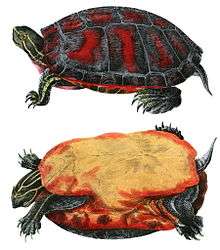Florida red-bellied cooter
| Florida red-bellied cooter | |
|---|---|
 | |
| Scientific classification | |
| Kingdom: | Animalia |
| Phylum: | Chordata |
| Subphylum: | Vertebrata |
| Class: | Reptilia |
| Order: | Testudines |
| Suborder: | Cryptodira |
| Family: | Emydidae |
| Subfamily: | Deirochelyinae |
| Genus: | Pseudemys |
| Species: | P. nelsoni |
| Binomial name | |
| Pseudemys nelsoni Carr, 1938 | |
| Synonyms[1] | |
| |
The Florida red-bellied cooter or Florida redbelly turtle (Pseudemys nelsoni ) is a species of turtle in the family Emydidae.
Etymology
The specific name, nelsoni, is in honor of American biologist George Nelson (born 1873).[2]
Geographic range
P. nelsoni is endemic to Florida, and southern Georgia.
Biology
The Florida redbelly cooter is mainly herbivorous, and can be found in nearly any type of aquatic habitat. It reaches particularly high densities in spring runs, and occasionally can be found in brackish water. This species is active year-round and spends a large portion of the day basking on logs. They are noted for sometimes laying their eggs in the nest mounds of alligators. The Florida redbelly is closely related to the Peninsula cooter (Pseudemys floridana) and can often be found basking on logs together.
Description
The Florida redbelly can be distinguished from other similar turtles by its distinctive red-tinged plastron (belly) and two cusps (like teeth) on its upper beak. Like most Pseudemys turtles, this species is a fairly large river turtle. Carapace length in mature turtles can range from 20.3 to 37.5 cm (8.0 to 14.8 in).[3] Females, which average 30.5 cm (12.0 in) in carapace length and weigh 4 kg (8.8 lb), are noticeably larger than males, which are around 25 cm (9.8 in) and 1.8 kg (4.0 lb) in mass.[4][5]
Export
Florida redbellies are commonly exported for consumption and the pet trade, with about 50% wild caught individuals and 50% captive bred.
Most of US export statistics (as collected by the World Chelonian Trust in 2002-2005) simply describe exported turtles by the genus, Pseudemys, without identifying the species. They are exported by the million, and are mostly farm-raised.[6]
.jpg)
References
- ↑ Fritz, Uwe; Havaš, Peter (2007). "Checklist of Chelonians of the World". Vertebrate Zoology. 57 (2): 195. Archived from the original (PDF) on 2010-12-17. Retrieved 29 May 2012.
- ↑ Beolens, Bo; Watkins, Michael; Grayson, Michael (2011). The Eponym Dictionary of Reptiles. Baltimore, Maryland: Johns Hopkins University Press. xiii + 296 pp. ISBN 978-1-4214-0135-5. (Pseudemys nelsoni, pp. 188-189).
- ↑
- ↑
- ↑
- ↑ Declared Turtle Trade From the United States - Pseudemys sp.
External links
- Florida red-bellied cooter Southeast Ecological Science Center.
Further reading
- Carr, A.F. (1938). "Pseudemys nelsoni, a New Turtle from Florida". Occ. Pap. Boston Soc. Nat. Hist. 8: 305-310. (Pseudemys nelsoni, new species).
- Ernst, C.H., R.W. Barbour and J.E. Lovich (1994). Turtles of the United States and Canada. Washington, District of Columbia: Smithsonian Institution Press.
- Hubbs, C. (1995). "Springs and spring runs as unique aquatic systems". Copeia 1995 (4): 989-991.
- Reed, R.N., and J.W. Gibbons (2004). "Conservation status of live U.S. nonmarine turtles in domestic and international trade" – a report to: U.S. Department of the Interior and U.S. Fish and Wildlife Service. Aiken, South Carolina, Savannah River Ecology Lab: 1-92.

